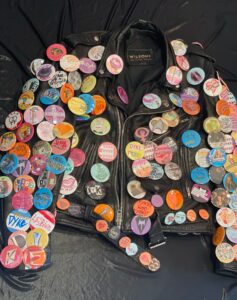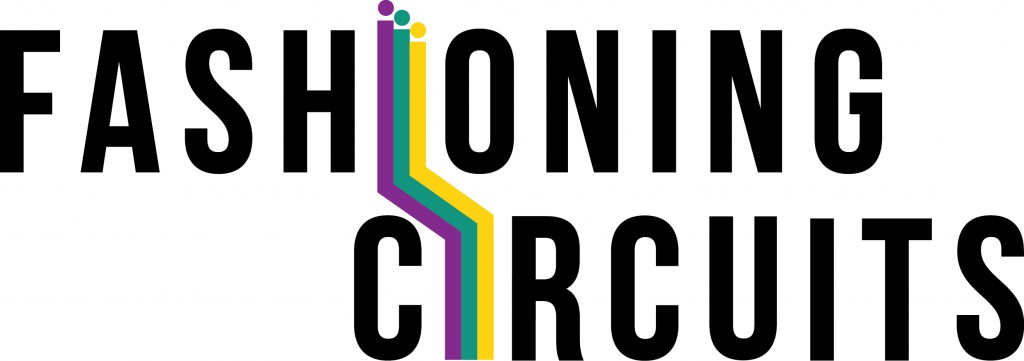We are excited to debut Words Matter 3.0 at the 2023 meeting of HASTAC, the Humanities, Arts, Sciences, Technology Alliance and Collaboratory. The HASTAC 2023 conference is themed “Critical Making and Social Justice.”
The installation will include wall text for the grouping of projects, but you can find more details about individual words and projects below. The words for Words Matter 3.0 are Activist, Artificial Intelligence, Dyke, Mahram, Paper, and Real.
Activist
Maker: Mohammed Mizanur Rashid
Activist intervenes in global LGBTQ+ activism and activist cultures through a participatory multi-media installation. The project aims to question narratives that promote and aggrandize hyper-visibility and coming out strategies in terms of LGBTQ+ activism, over secrecy, safety, and security of queer folks in extreme queerphobic socio-political environments. The installation consists of three small chests each containing secret letters written by unnamed LGBTQ+ community members living in Bangladesh, a nation-state with anti-LGBTQ+ and homophobic legislation. Interaction with the chests and letters mobilizes opportunities of reflection to think through the dangers of visible LGBTQ+ activism in many local contexts around the world. Activist ultimately invites participants to reconsider what activism means under such contexts and how certain aspects of activist cultures that negotiate and subvert visibility may be just as effective and sustainable as visible protests and activisms, if not more.
Bio: Mohammed Rashid (he/they)is a mixed media artist and doctoral candidate in the School of Arts, Humanities, and Technology at The University of Texas at Dallas. Their research and public humanities projectsexplore the invisible, enclave, and secret media cultures of Bangladeshi queer counter-publics to imagine a decolonial framework for South-Asian queer futurities. Their research and creative projects have appeared in the Media Fields Journal and Flow, and have been presented at conferences such as SCMS, HASTAC, PAMLA, and Queer Asia.
Artificial Intelligence
Maker: Yvonne Yu
Artificial Intelligence or AI has become a rapidly evolving technological tool. Its capabilities are claimed to be astonishing and innovative, but a deeper look reveals theft and poor quality. This installation criticizes the abilities of AI by presenting a Frankenstein-esque creation of the word by stitching together the works of famous artists from Keith Haring to Yoshimoto Nara. The word is shown on a retro PC monitor with a museum style frame to criticize those who claim AI is the future of art. Through the use of traditional mediums rather than digital, the piece aims to show the handmade skill and creativity of human artists that AI will never be able to truly generate or mimic.
Bio: Yvonne Yu (she/they) is a Chinese-American artist working toward a BA in Art, Technology, and Emerging Communication (ATEC) at the University of Texas at Dallas. She is focused on pursuing product design and specializes in traditional and digital illustrations, ceramic/clay sculptures, as well as textile art.
Dyke
Project Title: Pushing A Dyke’s Buttons (2023)
Maker: Fiona Haborak
Definitions for the phrase, dyke, acknowledge its contentious history as a lesbophobic slur (Merriam-Webster) and acknowledge its etymological root as a noun referring to a ditch or embankment (Oxford Dictionary). As a derogatory, bigoted expression used against lesbians, the phrase is often associated with masculinity in a same-sex relationship involving two women (Bates). Dyke is a charged word that synthesizes misogyny with homophobia, also possessing a deeply racialized history (Bates). In response, Pushing A Dyke’s Buttons (2023) serves as an act of reclamation by subverting dyke as a slur through repetition, feminist slogans, and iconography that celebrates lesbian joy and asserts visibility. This project synthesizes two wearable items – buttons and a leather jacket – due to their prevalence in the LGBTQ+ community. Akin to Joel Penney’s (2013) speculation on t-shirts that advocate for gay and lesbian visibility, this project relies on buttons as a form of protest, activism, and visibility. The jacket invokes associations of masculinity for butch lesbians within butch-femme couples, which is one example of lesbian relationships. Furthermore, framed around Jen Jack Gieseking’s (2015) concept of “useful in/stability,” the jacket operates as a wearable archive, disrupting the assumed societal norm of a conventional archive.
Collectively, the buttons are adhered to a worn, repurposed leather jacket to confront the viewer with the word, dyke, often attributed as a slur; instead, the buttons explore the etymology and includes iconography of famous lesbian figures, lesbian herstory, feminist symbols, popular culture icons related to lesbian desire, and academic phrases related to studies on the lesbian community. Thus, the word becomes a metaphorical and physical embrace. The buttons, inspired by those preserved in Lesbian archives across the United States, fortify the leather jacket as a suit of armor to tease out notions of masculinity and femininity as well as protection related to lesbian identity and lesbian existence. The jacket, converted into armor, emulates the pangolin animal in its scale-like appearance meant to protect the wearer from physical harm. This project is a living archive made by a lesbian seeking to affirm lesbian herstory through visual cues and phrases. Relying on the do-it-yourself ethos often correlated with LGBTQ+ protests, marches, and pride, the buttons employ mixed-media designs in a combination of hand-drawn and digitally manipulated images.

Bio: Fiona Haborak is a doctoral candidate in Arts, Technology, and Emerging Communication in the School of Arts, Humanities, and Technology at The University of Texas at Dallas and is the Assistant Production Editor for the Journal of Cinema and Media Studies (JCMS). Her research interests include cosplay, sapphic fandom, fan studies, digital media studies, and micro-celebrity. Her work assumes a do-it-yourself (DIY) approach drawing from her experience as a cosplayer.
Works Cited
Bates, Gloria. “Dyke: A Fracture in the Lesbian Community.” Think Queerly, June 2018, https://thinkqueerly.com/dyke-82d7e1db3498.
“Dike.” Oxford English Dictionary.com, Oxford English Dictionary, https://www.oed.com/view/Entry/52707.
“Dyke.” Merriam-Webster.com Dictionary, Merriam-Webster, https://www.merriam-webster.com/dictionary/dyke.
Gieseking, Jen Jack. “Useful In/stability: The Dialectical Production of the Social and Spatial Lesbian Herstory Archives.” Radical History Review, vol. 2015, no. 122, 2015, pp. 25-37.
Penney, Joel. “Eminently Visible: The Role of T-Shirts in Gay and Lesbian Public Advocacy and Community Building.” Popular Communication, vol. 11, no. 4, 2013, pp. 289-302, doi:10.1080/15405702.2013.838251.
Mahram
Makers: Cansu Nur Simsek, Zahra Jafarpour, Cameron Irby
The installation combines traditional textile techniques with digital technology to explore the impact of the word “mahram” on women’s lives in certain cultures, such as Iran and Turkey. The term is often used in discussions of gender relations and is considered an important component of Islamic ethics and social norms. The centerpiece of the installation is 20×25 inches of gray fabric with nine colorful, patterned, and textured pieces of fabric on it containing a drawing of a real person’s body part along with their corresponding real-life story who have experienced oppression and discrimination. Each hidden fabric reflects the multifaceted and rich internal lives of those subjected to the word “mahram,” here represented by the dull, rough, and uniform coverings hiding these portraits. Audiences can uncover the fabrics to view the drawing and read each story. The fabric frame is covered in stains (coffee, lipstick, wine, blood, and other fluids of indeterminate nature) subverting the connection between mahram and chastity or purity. By engaging with the installation and providing their own story-image combinations through the QR code, viewers become active participants in the process of promoting gender equality and creating more inclusive and equitable societies.
Bios: Cansu Nur Simsek (she/her) is a researcher who earned a Ph.D. on designed experience and environmental thinking in the School of Arts, Humanities, and Technology at the University of Texas at Dallas. She received an MA in communication studies, and bachelor’s in visual communication design. Her research interests include new media arts, visual culture studies, game studies, urban ecologies, and environmental justice issues.
Zahra Jafarpour (b. 1984 in Iran) is a conceptual and multimedia artist. After graduation in bachelor’s computer engineering, she earned two MFAs in Tehran, 2010 and Milan, 2018. Currently residing in Dallas, is pursuing a Ph.D. in Visual Arts at the University of Texas at Dallas. Jafarpour’s artwork revolves around the female body, social media and politic. Jafarpour’s works are often characterized by interact with the viewer.
Cameron Irby (he/him) is a Ph.D. candidate in the School of Arts, Humanities, and Technology (AHT) at the University of Texas at Dallas (UTD). After earning an MA in English, he is working to complete a dissertation on escapism and narrative media during the COVID-19 pandemic.
Kim Brillante Knight, PhD (she/they) is an Associate Professor of Critical Media Studies at The University of Texas at Dallas. She is the director of Fashioning Circuits and the producer of Words Matter 3.0. In Fall 2023 she will join the faculty of San José State University as Associate Professor of Digital Humanities.
Paper
Maker: Nusrat Chowdhury
The installation features a backpack embellished with various kinds of paper and printed documents that immigrants require to legally enter and stay in the US. The backpack gestures towards the crossing of US borders by thousands of undocumented migrants who take the tedious path of both land and water to enter the US territory under various circumstances. The project thus not only represents the undocumented migrants carrying backpacks but also the toils and struggles of crossing the border and beyond. The installation subverts the idea of official documentation, widely known as papers, by printing them on colorful papers and adding textures to them.
Bio: Nusrat Chowdhury (She/her) is a Ph.D. candidate in the School of Arts, Humanities, and Technology (AHT) at the University of Texas at Dallas (UTD). She is a graduate teaching associate at her school. She received master’s in applied Linguistics and ELT, and Bachelor’s in English Language and Literature. Her research interests are geared towards social justice issues and feminist activism.
Real
Maker: Logan Acton
What qualifies as ‘real’ has a long history of contestation, from Plato’s Allegory of the Cave to the development of germ theory and other ideas about that which we cannot easily see. In our own moment, claims to truth have become central in public discourse as the term ‘fake news’ became weaponized and part of daily media reporting on politics. Here, the reference to lace and the emphasis on shadow propose questions regarding the fragility of what we may consider real, whether our understanding of reality is something tangible or primarily experienced through absence, and the role of illusion or even seduction in our interpretation of truth. In taking form through a plastic representation of delicate fabric, we may even be reminded of Baudrillard’s concept of the hyperreal, a term used “to suggest that our knowledge of the world is drawn from media images of reality rather than direct experience of it. The signs contained in media images constitute hyperreality and in the postmodern world are our main source of knowledge.” 1
You are invited to use the flashlight provided to explore the different shadows created.
Bio: Logan Hamilton Acton is an interdisciplinary artist, designer, and researcher whose practice meditates on meaning and the psychological constructs through which we navigate contradictory experiences. Acton earned his BA in Art & Performance and his MA in Aesthetic Studies from the University of Texas at Dallas (UTD), going on to study at the Kansas City Art Institute and complete his MFA in Sculpture at Cranbrook Academy of Art. He is pursuing his PhD in Arts, Technology, and Emerging Communication at UTD through research focused on digital craft.
